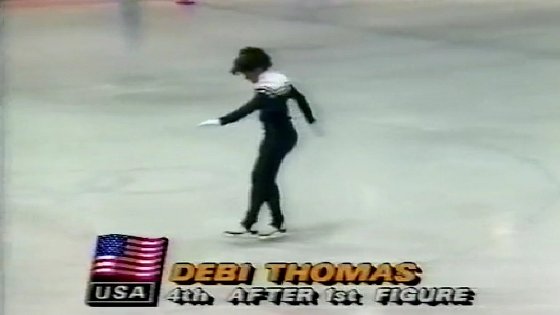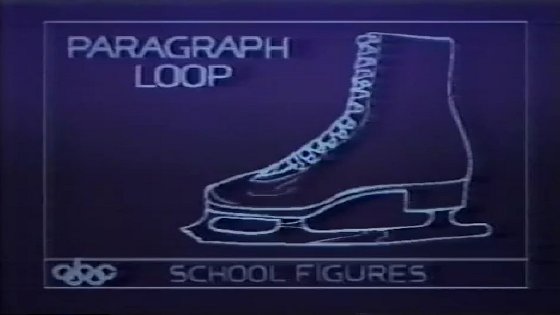3: “FIGURE 8” EXERCISES: What are they? How do they apply to piano?
I borrowed the term “Figure-8” from the world of Olympic figure skating. If you aren’t familiar with figure skating, a little background and demonstration on that subject might be helpful.
Please note that I address both questions in the second half of this post. So if you’d like to skip past the “FIGURE 8s” IN OLYMPIC SKATING background/demonstration section that follows next, you can go directly to the “FIGURE 8s” in Piano and Music section by clicking here.
There was a period of time when Olympic ice skating competitors were required to participate in the Compulsory Figures Competition. They had to skate a certain number of compulsory figures into the ice and then re-skate or trace-over the figures. All of the figures were based on or derivatives of the number “eight”, thus the term “Figure 8” skating. At first there were twelve figures but over the years, the number was gradually reduced and by 1973, only three compulsory figures remained. Skaters were scored on how well each figure was initially etched or engraved, and on how well they traced-over each original skating.
Compulsory figures were eliminated entirely from international competition after 1990, so videos and rebroadcasts are perhaps your main avenue of seeing what I hope doesn’t become a lost art form! If you haven’t seen Olympic figure skating in live broadcasts or taped reruns, I’d like to have you take a look at the next several clips from that world because seeing the skaters create and then trace the figures will help me draw a picture of the parallels I see.
When I first watched the introductory commentary clip just below, I smiled when the comparisons of skating fundamentals and the musical scales of a pianist was made because I completely agree with what was said.
The Paragraph Loop figure, with its sub-loop variation within each of its two circles, seemed to be the most challenging of the three remaining figures to skate and trace. This was my favorite event to watch because of the discipline, skill, control, grace, precision, stamina, mental toughness, and strength it took to pull it off. Check out the following really short video clips on “Figure 8” skating before returning your focus to the music world.
“FIGURE 8s” IN OLYMPIC SKATING
Commentary on Compulsory Figures – “They are really basically like the scales for a pianist.”

Clip #1 – The Counter figure is Illustrated

Clip #2 – The Paragraph Bracket figure is Illustrated

Clip #3 – Debi Thomas Skates The Paragraph Bracket

Clip #4 – The Paragraph Loop figure is Illustrated

Clip #5 – Debi Thomas Skates The Paragraph Loop

Setting skating aside, does this illustration of the Counter remind you of anything?
Which of the three answers below do you think would be the most chosen
in a David Letterman-like picture association skit or poll? (drum roll please…)
1. A snow man;
2. Three scoops of vanilla ice cream;
3. The notes of a musical triad;
A case could be made for #s 1 and 2 but I think the Letterman answer might be #3, a musical triad! Paul Shaffer might say “Yeah! Let’s run with that one!” as we shift our focus back to music.
Speaking of music… the tune you hear upon clicking the Counter graphic just above is is an original tune of mine titled, “The Counter” (©2013). The melody uses C-E-G only so that beginners and everyone can easily Jam along with it and improvise during the solo section! I invite you to post a video of yourself jamming and improvising to this little ditty on my YouTube “The Counter” post. If you like, right-click and save an mp3 of the music here.
“FIGURE 8s” in Piano and Music
“Figure-8s”, as I use the term in piano lessons, are musical figures which, once played, must be repeated or “traced” two or more times and as smoothly as possible in a manner that is figuratively similar to the way tracing was done in the world of figure skating. The length and complexity of the figures may vary but the object is to have your fingers remain in continuous contact with the piano keyboard while you’re executing and tracing so that the figure remains unbroken and true-to-form during the entire exercise.
“Figure 8s” on a major triad
In the videos just below you’ll see me “figure 8” the notes of a C major triad which make my “target notes” C, E, and G. To “figure 8” the notes, I use a 2-note ornament that starts with a scale step above the target note, passes through the target note to a half-step below the target note then returns to the target note so that the figure-8 ornamenting of each target note will consist of 4 tones being played. In short, I “hang” a two-note ornament on each of the three target notes. The video starts with me “figure 8-ing” Middle C by practicing the 2-note ornament around that single note before I move on to practice the same ornament on the other two notes. (See the major triad videos)
“Figure 8s” on a minor triad
In the videos just below you’ll see me “figure 8” the notes of a C minor triad which make my “target notes” C, Eb, and G. To “figure-8” the notes, I use a 3-note ornament that starts with a half-step below the target note then moves directly to a whole step above the target note then makes a chromatic 2-note slide which ends directly on the target note so that the figure-8 ornamenting of each target note will consist of 4 tones being played. In short, I “hang” a 3-note ornament on each of the three target notes. The video starts with me “figure 8-ing” Middle C by practicing the 3-note ornament around that single note only before I move on to practice the same ornament on the other two notes. (See the minor triad videos)
In the context of piano technique, these “Figure 8” piano finger patterns and exercises require the same characteristics as those I mentioned near the top of this post in the ice skating context. As you work with these exercises, practice slowly and strive for evenness and accuracy. Speed will always come to you as a by-product of slow efficient practice!
I encourage you to come up with your own “Figure 8s” too. Your figures may vary in size from very short ornaments, like the ones I used in this post, to longer phrases, like the one in the interactive picture just below.
With the use of rhythmic and pitch variation, the possibilities are virtually limitless!
Of course all of the exercises discussed and demonstrated in this three-post topic, as well as any you may make or find elsewhere, won’t give you the ability to leap tall buildings in a single bound or be faster than a speeding bullet! However, if you are persistent, patient, and do the exercises I recommended in this post in all 12 keys, your fingers will learn to do things and go places they’ve never gone before on the piano keyboard.
Practice well and have fun!
See you next post.
Art

